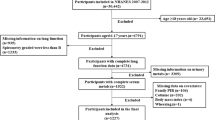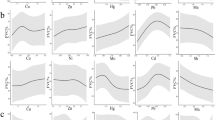Abstract
Accumulating evidence has shown that toxic metals exposure can have adverse effects on children, but the effects of blood Pb, Hg, and Cd co-exposure on pulmonary function in children remains to be clarified. This cross-sectional multicenter study was conducted in Wuxi City, China. A total of 221 healthy children free from chronic obstructive pulmonary disease were recruited. The blood samples were collected while blood Pb, Hg, and Cd levels were determined. The forced vital capacity volume (FVC) and forced expiratory volume in the 1 s (FEV1) were measured. The associations between metals concentration and pulmonary function were analyzed by multiple linear regression models. The geometric means of the blood Pb, Hg, and Cd levels in our study were 37.27 μg/L, 1.41 μg/L, and 0.28 μg/L, respectively. After adjusting for age, sex, maternal education, annual family income, fish consumption, and second-hand smoking exposure, only the blood Pb levels were significantly negatively associated with the pulmonary function. In addition, a significantly positive interaction between blood Pb and blood Cd on pulmonary function were also detected. Although causal relationship cannot be confirmed in this study, at least higher levels of Pb in blood are associated with decreased pulmonary parameters in children.
Similar content being viewed by others
References
Council On Environmental Health (2016) Prevention of childhood lead toxicity. Pediatrics. 138(1):e20161493. https://doi.org/10.1542/peds.2016-1493
Zhou CC, Gao ZY, He YQ, Wu MQ, Chen F, Wang J, Liu JX, Yan CH (2019) Effects of lead, mercury, aluminium and manganese co-exposure on the serum BDNF concentration of pre-school children in Taizhou, China. Chemosphere 217:158–165. https://doi.org/10.1016/j.chemosphere.2018.11.028
Zhou CC, Gao ZY, Wang J, Wu MQ, Hu S, Chen F, Liu JX, Pan H, Yan CH (2018) Lead exposure induces Alzheimers's disease (AD)-like pathology and disturbes cholesterol metabolism in the young rat brain. Toxicol Lett 296:173-183. https://doi.org/10.1016/j.toxlet.2018.06.1065
Urushidate S, Matsuzaka M, Okubo N, Iwasaki H, Hasebe T, Tsuya R, iwane K, Inoue R, Yamai K, Danjo K, Takahashi I, Umeda T, Ando S, Itai K, Nakaji S (2010) Association between concentration of trace elements in serum and bronchial asthma among Japanese general population. J Trace Elem Med Biol 24:236–242. https://doi.org/10.1016/j.jtemb.2010.06.001
Ahmed S, Akhtar E, Roy A, von Ehrenstein OS, Vahter M, Wagatsuma Y, Raqib R (2017) Arsenic exposure alters lung function and airway inflammation in children: a cohort study in rural Bangladesh. Environ Int 101:108–116. https://doi.org/10.1016/j.envint.2017.01.014
Huang X, Xie J, Cui X, Zhou Y, Wu X, Lu W, Shen Y, Yuan J, Chen W (2016) Association between concentrations of metals in urine and adult asthma: a case-control study in Wuhan, China. PLoS One 11:e0155818. https://doi.org/10.1371/journal.pone.0155818
Zeng X, Xu X, Zheng X, Reponen T, Chen A, Huo X (2016) Heavy metals in PM2.5 and in blood, and children's respiratory symptoms and asthma from an e-waste recycling area. Environ Pollut 210:346–353. https://doi.org/10.1016/j.envpol.2016.01.025
Wang IJ, Karmaus WJJ, Yang CC (2017) Lead exposure, IgE, and the risk of asthma in children. J Expo Sci Environ Epidemiol 27:478–483. https://doi.org/10.1038/jes.2017.5
Zeng X, Xu X, Boezen HM, Vonk JM, Wu W, Huo X (2017) Decreased lung function with mediation of blood parameters linked to e-waste lead and cadmium exposure in preschool children. Environ Pollut 230:838–848. https://doi.org/10.1016/j.envpol.2017.07.014
Kim KN, Bae S, Park HY, Kwon HJ, Hong YC (2015) Low-level mercury exposure and risk of asthma in school-age children. Epidemiology 26:733–739. https://doi.org/10.1097/EDE.0000000000000351
Pateda SM, Sakakibara M, Sera K (2018) Lung function assessment as an early biomonitor of mercury-induced health disorders in artisanal and small-scale gold mining areas in Indonesia. Int J Environ Res Public Health 15. https://doi.org/10.3390/ijerph15112480
Hossny E, Mokhtar G, El-Awady M, Ali I, Morsy M, Dawood A (2001) Environmental exposure of the pediatric age groups in Cairo City and its suburbs to cadmium pollution. Sci Total Environ 273:135–146
Gao W, Li Z, Kaufmann RB, Jones RL, Wang Z, Chen Y, Zhao X, Wang N (2001) Blood lead levels among children aged 1 to 5 years in Wuxi City, China. Environ Res 87:11–19. https://doi.org/10.1006/enrs.2001.4281
Haines DA, Khoury C, Saravanabhavan G, Werry K, Walker M, Malowany M (2017) Human biomonitoring reference values derived for persistent organic pollutants in blood plasma from the Canadian health measures survey 2007-2011. Int J Hyg Environ Health 220:744–756. https://doi.org/10.1016/j.ijheh.2017.03.004
Bagci C, Bozkurt AI, Cakmak EA, Can S, Cengiz B (2004) Blood lead levels of the battery and exhaust workers and their pulmonary function tests. Int J Clin Pract 58:568–572
Khazdair MR, Boskabady MH, Afshari R, Dadpour B, Behforouz A, Javidi M, Abbasnezhad A, Moradi V, Tabatabaie SS (2012) Respiratory symptoms and pulmonary function testes in lead exposed workers. Iran Red Crescent Med J 14:737–742. https://doi.org/10.5812/ircmj.4134
Little BB, Ignasiak Z, Slawinska T, Posluszny P, Malina RM, Wiegman DL (2017) Blood lead levels, pulmonary function and agility in Polish schoolchildren. Ann Hum Biol 44:723–728. https://doi.org/10.1080/03014460.2017.1387284
Olmo R, Teijon C, Muniz E, Beneit JV, Villarino AL, Blanco MD (2012) Modulation of lysozyme activity by lead administered by different routes. In vitro study and analysis in blood, kidney, and lung. Biol Trace Elem Res 149:405–411. https://doi.org/10.1007/s12011-012-9446-1
Stohs SJ, Bagchi D (1995) Oxidative mechanisms in the toxicity of metal ions free Radic. Biol Med 18:321–336
Boskabaddy MH, Farkhondeh T (2013) Inhaled lead exposure affects tracheal responsiveness and lung inflammation in Guinea pigs during sensitization. Biol Trace Elem Res 154:363–371. https://doi.org/10.1007/s12011-013-9742-4
Boskabady MH, Tabatabai SA, Farkhondeh T (2016) Inhaled lead affects lung pathology and inflammation in sensitized and control Guinea pigs. Environ Toxicol 31:452–460. https://doi.org/10.1002/tox.22058
Heo Y, Lee BK, Ahn KD, Lawrence DA (2004) Serum IgE elevation correlates with blood lead levels in battery manufacturing workers. Hum Exp Toxicol 23:209–213. https://doi.org/10.1191/0960327104ht442oa
Park S, Lee EH, Kho Y (2016) The association of asthma, total IgE, and blood lead and cadmium levels. J Allergy Clin Immunol 138:1701–1703 e1706. https://doi.org/10.1016/j.jaci.2016.04.030
Gao ZY, Li MM, Wang J, Yan J, Zhou CC, Yan CH (2018) Blood mercury concentration, fish consumption and anthropometry in Chinese children: a national study. Environ Int 110:14–21. https://doi.org/10.1016/j.envint.2017.08.016
Xu X, Liao W, Lin Y, Dai Y, Shi Z, Huo X (2018) Blood concentrations of lead, cadmium, mercury and their association with biomarkers of DNA oxidative damage in preschool children living in an e-waste recycling area. Environ Geochem Health 40:1481–1494. https://doi.org/10.1007/s10653-017-9997-3
Miyake Y, Tanaka K, Yasutake A, Sasaki S, Hirota Y (2011) Lack of association of mercury with risk of wheeze and eczema in Japanese children: the Osaka maternal and child health study. Environ Res 111:1180–1184. https://doi.org/10.1016/j.envres.2011.07.003
Shaheen SO, Newson RB, Henderson AJ, Emmett PM, Sherriff A, Cooke M, Team AS (2004) Umbilical cord trace elements and minerals and risk of early childhood wheezing and eczema. Eur Respir J 24:292–297
Li H, Li H, Li Y, Liu Y, Zhao Z (2018) Blood mercury, arsenic, cadmium, and lead in children with autism spectrum disorder. Biol Trace Elem Res 181:31–37. https://doi.org/10.1007/s12011-017-1002-6
Ilmiawati C, Yoshida T, Itoh T, Nakagi Y, Saijo Y, Sugioka Y, Sakamoto M, Ikegami A, Ogawa M, Kayama F (2015) Biomonitoring of mercury, cadmium, and lead exposure in Japanese children: a cross-sectional study. Environ Health Prev Med 20:18–27. https://doi.org/10.1007/s12199-014-0416-4
Hruba F et al (2012) Blood cadmium, mercury, and lead in children: an international comparison of cities in six European countries, and China, Ecuador, and Morocco. Environ Int 41:29–34. https://doi.org/10.1016/j.envint.2011.12.001
Rokadia HK, Agarwal S (2013) Serum heavy metals and obstructive lung disease: results from the National health and nutrition examination. Survey Chest 143:388–397. https://doi.org/10.1378/chest.12-0595
Leem AY et al (2015) Relationship between blood levels of heavy metals and lung function based on the Korean National health and nutrition examination survey IV-V. Int J Chron Obstruct Pulmon Dis 10:1559–1570. https://doi.org/10.2147/COPD.S86182
Chen X, Zhou H, Li X, Wang Z, Zhu G, Jin T (2015) Effects of lead and cadmium co-exposure on hemoglobin in a Chinese population. Environ Toxicol Pharmacol 39:758–763. https://doi.org/10.1016/j.etap.2015.02.005
Hambach R, Lison D, D’Haese PC, Weyler J, de Graef E, de Schryver A, Lamberts LV, van Sprundel M (2013) Co-exposure to lead increases the renal response to low levels of cadmium in metallurgy workers. Toxicol Lett 222:233–238. https://doi.org/10.1016/j.toxlet.2013.06.218
Claus Henn B et al (2012) Associations of early childhood manganese and lead coexposure with neurodevelopment. Environ Health Perspect 120:126–131. https://doi.org/10.1289/ehp.1003300
Funding
This study was supported by the Medical Innovation Team of Jiangsu Province (Grant No. CXTDB 2017016). The Major Program of Wuxi health and Family Planning Commission (z201606). Wuxi Medical Talents (Grant No. QNRC071). The Youth project of Wuxi health and Family Panning Commission (Q201837). The general Program of Nanjing Medical University(2016NJMU119).
Author information
Authors and Affiliations
Corresponding author
Ethics declarations
Conflict of Interest
The authors declare that they have no conflict of interest.
Additional information
Publisher’s Note
Springer Nature remains neutral with regard to jurisdictional claims in published maps and institutional affiliations.
Rights and permissions
About this article
Cite this article
Pan, Z., Guo, Y., Xiang, H. et al. Effects of Lead, Mercury, and Cadmium Co-exposure on Children’s Pulmonary Function. Biol Trace Elem Res 194, 115–120 (2020). https://doi.org/10.1007/s12011-019-01772-w
Received:
Accepted:
Published:
Issue Date:
DOI: https://doi.org/10.1007/s12011-019-01772-w




